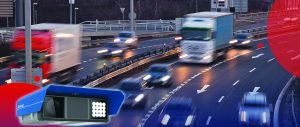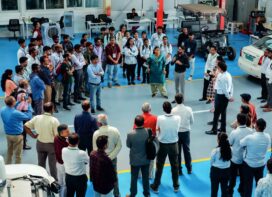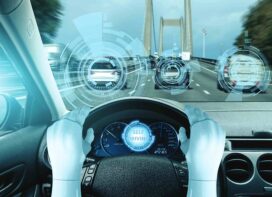 Keeping in view the increasing traffic congestion on Indian roads and the ever growing road accident fatality, it has been widely felt that implementation of Intelligent Traffic Management Systems at all urban roads is absolutely essential. Focusing on the multifarious capabilities of the latest Video Security System based ITMS, Ashish P Dhakan, MD & CEO, Prama Hikvision India Pvt Ltd, strongly advocates implementation of these solutions on Indian roads
Keeping in view the increasing traffic congestion on Indian roads and the ever growing road accident fatality, it has been widely felt that implementation of Intelligent Traffic Management Systems at all urban roads is absolutely essential. Focusing on the multifarious capabilities of the latest Video Security System based ITMS, Ashish P Dhakan, MD & CEO, Prama Hikvision India Pvt Ltd, strongly advocates implementation of these solutions on Indian roads
What are the major changes in the last five years that have made Video- Surveillance -based Intelligent Traffic Management for urban areas essential?
There are many positive changes that are visible in the urban areas due to Video Security-based Traffic Management Solutions. These changes include, effective traffic management, fast growing vehicular traffic, lesser traffic congestion, improved compliance, speedy resolution of traffic violation cases (E-Challan and Virtual Courts), video evidence, reduced accident rates and growing awareness.
Across the Indian cities the poor quality of roads, encroachments and insufficient transport infrastructure impede the smooth traffic flow. There is a growing concern about air and sound pollution happening due to traffic congestion.
Transportation plays a significant role in the transformation of a city’s core infrastructure. An intelligent transport management system is the one which is integrated with Information and Communication Technology that ensures easy commute options for the people. With millions of people choosing to commute via different public transportation options, having a system that is smooth, hassle-free and quick is crucial. An intelligent transport management system is not only seamless and quick but also safe and reliable. This balance helps the commuters and ensures overall efficiency in the city.
How is the concept being implemented by the urban development authorities?
The urban development authorities are implementing the system for effective traffic management and better compliance rate. It has helped to evolve traffic management reforms and initiatives like E-Challan, Virtual Courts and FASTag.
The Government has implemented E-Challan System to effectively check violations like drunk driving, over speeding and other traffic laws. It is an integrated information technology based enforcement solution to manage traffic laws violations through an Android-based mobile app and back-end web application for use by the Transport Enforcement Wing and Traffic Police. E-Challan System has been implemented in Chandigarh, Delhi, Gujarat, Haryana, Maharashtra, Orissa, Rajasthan, Tamil Nadu and Uttar Pradesh.
Virtual Court is an initiative of the E-Committee of Supreme Court along with Department of Justice, Ministry of Law& Justice, Government of India. Currently, there are nine Virtual courts functioning in India- Delhi (2 Courts), Haryana (Faridabad), Maharashtra (Pune), Tamil Nadu (Chennai), Karnataka (Bengaluru), Maharashtra (Nagpur), Kerala (Kochi) and Assam (Gauhati). They are all dealing with Traffic Challan cases only.
National Electronic Toll Collection programme has been implemented on pan India basis. It is using passive Radio Frequency Identification technology.
“Multi-dimensional perception capabilities will play a fundamental role in taking the video security industry to the next level, and we constantly see growing numbers of integrated security devices and systems with multiple sensors.”
 What are the different traffic management tools or equipment in operation at present?
What are the different traffic management tools or equipment in operation at present?
Indian cities have deployed a diverse range of traffic management tools and systems depending on the specific requirements. The metros, cities, towns and villages have a different set of requirements while highways, tunnels, over bridges and flyovers have special systems for traffic management. Traffic Management Systems include Special Video Security Cameras (ANPR, Speed Detection, Red Light Violation Detection (RLVD), etc.), Intelligent Transportation Systems (ITS), Advanced Traveler Information System (ATIS), Advanced Traffic Management System (ATMS) and Advanced Public Transportation System (APTS).
The other solutions include Sensors, Display Boards, Software (Route Guidance, Smart Signalling, Traffic Analytics, Video Analytics Software, Video Management Software), Service (Integration, Maintenance & Support, Consulting) and deployment model (On-Premises, Cloud). The traffic systems by application include Adaptive Traffic Control System, Dynamic Traffic Management System, Incident Detection & Location System, Journey Time Measurement System, Predictive Time Modelling System and Urban Traffic Management & Control System. Also being used are static and mobile Variable Message Signs, Vehicle Activated Speed Signs and passenger information display systems.
The key traffic management systems include Advanced Traveller Information System (ATIS), Advanced Traffic Management System (ATMS) and Advanced Public Transportation System (APTS). With the help of ATMS the congested traffic situations on the roads can be managed. APTMS can help to improve the current situation of public transport by rescheduling and proper management of available fleets to encourage the commuters to use public transport more as compared to private cars and bikes. ATIS can give the users pre-trip and enroute information so that they can plan their trip properly, it will help in reducing the time spent by the riders on the roads and also help them to avoid traffic jams on the roads.
Where does India stand in terms of global practices in implementing the traffic management tools?
India is still way behind other developed countries in terms of implementing advanced traffic management tools and global best practices. There are terrible traffic congestion problems in India’s tier-I and tier-II cities. Building infrastructure, levying proper taxes to curb private vehicle growth and improving public transport facilities are long-term solutions to this problem. These permanent solution approaches need government intervention.
The government is continuously doing reforms in the transportation sector with initiatives like National Urban Transport Policy, 2014, Atal Mission for Rejuvenation and Urban Transformation, Automotive Mission Plan 2016-26, Make in India, National Manufacturing Policy, Skill Development, FAME India Scheme and Voluntary Vehicle Modernisation (End of Life Policy). A combination of strong policies, regulation, public and private sector investments, and public awareness will bring the desired change for implementing and executing the dream of smart transportation in the country.
Your take on Indianization of the Video- Surveillance equipment based on India’s climatic condition…
The localisation or Indianisation of Video Security Technology, Products and Solutions is a key requirement for Original Equipment Manufacturers, since most of them are located out of India. They follow the standards and specifications based on their foreign locations. Customization of the products and technology as per the local environment are a couple of key aspects of our local manufacturing initiative.
Hikvision India has one of the largest local video security equipment manufacturing plants in India. It is backed by the Research and Development Center. Our R&D team strives to match the expectations of the end-users and delivers the video security solutions best suited to their requirements. These Video Security products are produced in India as per Indian standards and guidelines.
What about the convergence of multiple surveillance systems? What are the technical challenges and shortcomings which need to be addressed?
The Multiple surveillance system or Multi-dimensional perception trend is driving the convergence of different video security systems into a single system. Now, more perception capabilities, such as radar detection, multispectral imagery, humidity and temperature measurement, and gas pressure detection, are being integrated with video cameras and systems. This integration extends perception capabilities of these video cameras and systems, and widens their applications by enabling the collection and use of multi-dimensional information.
Here, the video security systems would require a robust platform and seamless network connectivity for efficient performance and delivery. The foreseeable challenges of multiple surveillance system would include interoperability, seamless network connectivity and integration with command and control center.
Hikvision India has recently introduced the new All-Rounder ITS camera. It is engineered with an all-in one structure, embedding video, radar, and supplemental light in one module, helping traffic authorities to easily ramp up the detection of violations. Beyond the visual range that is perceived by video cameras, the abilities to understand other kinds of “senses” would allow even more precise monitoring and reporting of events or accidents. This is multi-dimensional perception, a trend that will drive the security industry in the future.

How do you perceive the introduction of 5G technology strengthening ITMSs?
5G technology may bring many positive changes to the security industry. It’s greater bandwidth and lower latency makes the regular transmission of high-quality images possible, and, with the widespread adoption of ultra-high-definition (UHD) cameras, could bring new opportunities for video security Industry and strengthen the Video Security-based Intelligent Traffic Management systems. It also enhances digital experiences through machine-learning enabled automation.
5G technology is here to enhance security with greater bandwidth and lower latency. It can boost the safety of your network devices by tailoring security updates and improving encryption. There are a few major security wins in 5G. To do this, 5G’s capability to tailor security updates for every single device, and also its ability to boost encryption between those devices. Boosting encryption similarly goes hand in hand with the increased reliability of Network devices as promised by 5G. This technology is also a much more application-based and cloud-based system than previous wireless networks, which will allow for better monitoring to spot potential threats.
Five key functional drivers of 5G support certain technological applications. They are: enhanced mobile broadband; ultra-reliable, low latency communication; security; massive machine-type communications; and power efficiency.
What are the pros and cons of cloud-based security systems in traffic management?
Cloud based security system refers to a wide range of traffic management related data, software and applications stored onto the cloud. Most organizations have shifted their business information to cloud services from the traditional in premises access of data.
The benefits of a secure cloud-based security systems in traffic management include, advantages of concentration of resources, cost savings, updates and default options more efficient and effective, audit and evidence collection, rapid and intelligent resource escalation and standardized interfaces for managed security services. A secure cloud-based security system in traffic management offers security as a differentiating element. It further leverages the advantages of scale to traffic management data and video analytics. The risks of cloud- based security systems in traffic management include, loss of governance, dependence, insulation failure, compliance risks, management interface commitment, data protection, deletion of insecure or incomplete data and malicious member.
According to NASSCOM and Data Security Council of India study, “Security concerns over cloud can be best addressed through voluntary adoption of cyber security standards and best practices by Cloud Service Providers (CSPs) and customers. The cyber threat landscape is ever evolving, and regulatory prescriptions will only drive companies towards compliance instead of addressing such evolving threats. International Standards for cloud security are already available and many are evolving (ISO/IEC 27001, ISO/IEC 27017, ISO/IEC 27018 etc.). The end-users are increasingly asking CSPs for compliance to such standards.”
What are the most essential practices that should be for urban areas?
We strive to ensure our transportation management solutions support smarter and greener cities, and help make essential parts of daily life like commuting and parking easier. Hikvision India has introduced a suite of intelligent transportation solutions and products including traffic cameras and monitoring systems, intelligent traffic system, smart mobile enforcement and streamlined parking solution.
Traffic control and monitoring systems: Boasting traffic violation detection, license plate recognition, vehicle feature recognition and speeding capture, the Hikvision traffic cameras are going to be demonstrated for checkpoint, intersection and highway uses. The cameras observe and monitor traffic flow, when traffic build-up at an intersection is identified, Hikvision traffic signal control solutions allows traffic lights to be coordinated to keep traffic flowing as freely as possible.
Intelligent Traffic System: The Intelligent Traffic System plays a pivotal role in managing the traffic effectively. In this context, Hikvision’s Intelligent Traffic Management System (ITMS) offers safe and smooth solutions. These include Video Security, Speed Detection, Red Light Violation Detection , Highway Event Detection, Illegal Parking, Mobile Enforcement and Traffic Volume Detection. We have implemented these solutions in some states. We also offer E-Challan System for Traffic Violations like Red light violation, triple riding, driving without helmet and wrong side driving.
Smart mobile enforcement: Hikvision India has a set of smart mobile devices for road patrolling and enforcement purposes. Attendees will be able to experience the live demonstration of a Hikvision vehicle-mounted panoramic PTZ kit, which is designed to give a panoramic view of the surroundings when the police van is on duty. The camera is capable of license plate recognition and illegal parking capture.
Another example is the Hikvision’s rugged, wearable body cameras and the corresponding Dock Station for charging and data collection. Equipped with GPS locators, the cameras give the control center the ability to find out where an incident is occurring and provide back up, for example.
Streamlined parking solution: Hikvision has its state-of-the-art smart parking solution. It gives customers precise parking guidance using indicator lights and displays, straightforward vehicle search at kiosks, and quick entry and exit with ANPR systems.
 TrafficInfraTech Magazine Linking People Places & Progress
TrafficInfraTech Magazine Linking People Places & Progress


